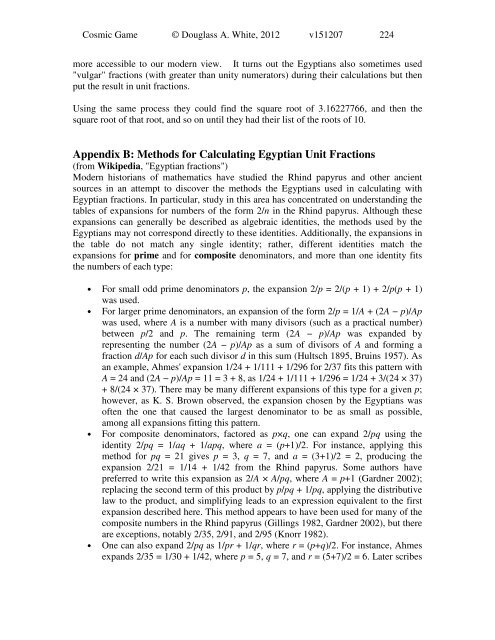You also want an ePaper? Increase the reach of your titles
YUMPU automatically turns print PDFs into web optimized ePapers that Google loves.
<strong>Cosmic</strong> <strong>Game</strong> © Douglass A. White, 2012 v151207 224<br />
more accessible to our modern view. It turns out the Egyptians also sometimes used<br />
"vulgar" fractions (with greater than unity numerators) during their calculations but then<br />
put the result in unit fractions.<br />
Using the same process they could find the square root of 3.16227766, and then the<br />
square root of that root, and so on until they had their list of the roots of 10.<br />
Appendix B: Methods for Calculating Egyptian Unit Fractions<br />
(from Wikipedia, "Egyptian fractions")<br />
Modern historians of mathematics have studied the Rhind papyrus and other ancient<br />
sources in an attempt to discover the methods the Egyptians used in calculating with<br />
Egyptian fractions. In particular, study in this area has concentrated on understanding the<br />
tables of expansions for numbers of the form 2/n in the Rhind papyrus. Although these<br />
expansions can generally be described as algebraic identities, the methods used by the<br />
Egyptians may not correspond directly to these identities. Additionally, the expansions in<br />
the table do not match any single identity; rather, different identities match the<br />
expansions for prime and for <strong>com</strong>posite denominators, and more than one identity fits<br />
the numbers of each type:<br />
• For small odd prime denominators p, the expansion 2/p = 2/(p + 1) + 2/p(p + 1)<br />
was used.<br />
• For larger prime denominators, an expansion of the form 2/p = 1/A + (2A − p)/Ap<br />
was used, where A is a number with many divisors (such as a practical number)<br />
between p/2 and p. <strong>The</strong> remaining term (2A − p)/Ap was expanded by<br />
representing the number (2A − p)/Ap as a sum of divisors of A and forming a<br />
fraction d/Ap for each such divisor d in this sum (Hultsch 1895, Bruins 1957). As<br />
an example, Ahmes' expansion 1/24 + 1/111 + 1/296 for 2/37 fits this pattern with<br />
A = 24 and (2A − p)/Ap = 11 = 3 + 8, as 1/24 + 1/111 + 1/296 = 1/24 + 3/(24 × 37)<br />
+ 8/(24 × 37). <strong>The</strong>re may be many different expansions of this type for a given p;<br />
however, as K. S. Brown observed, the expansion chosen by the Egyptians was<br />
often the one that caused the largest denominator to be as small as possible,<br />
among all expansions fitting this pattern.<br />
• For <strong>com</strong>posite denominators, factored as p×q, one can expand 2/pq using the<br />
identity 2/pq = 1/aq + 1/apq, where a = (p+1)/2. For instance, applying this<br />
method for pq = 21 gives p = 3, q = 7, and a = (3+1)/2 = 2, producing the<br />
expansion 2/21 = 1/14 + 1/42 from the Rhind papyrus. Some authors have<br />
preferred to write this expansion as 2/A × A/pq, where A = p+1 (Gardner 2002);<br />
replacing the second term of this product by p/pq + 1/pq, applying the distributive<br />
law to the product, and simplifying leads to an expression equivalent to the first<br />
expansion described here. This method appears to have been used for many of the<br />
<strong>com</strong>posite numbers in the Rhind papyrus (Gillings 1982, Gardner 2002), but there<br />
are exceptions, notably 2/35, 2/91, and 2/95 (Knorr 1982).<br />
• One can also expand 2/pq as 1/pr + 1/qr, where r = (p+q)/2. For instance, Ahmes<br />
expands 2/35 = 1/30 + 1/42, where p = 5, q = 7, and r = (5+7)/2 = 6. Later scribes





